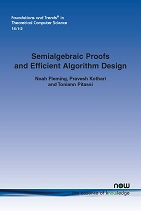Semialgebraic Proofs and Efficient Algorithm Design
By Noah Fleming, University of Toronto, USA, noahfleming@cs.toronto.edu | Pravesh Kothari, Princeton University, USA, kothari@cs.princeton.edu | Toniann Pitassi, University of Toronto & IAS, Canada, toni@cs.toronto.edu
Abstract
Over the last twenty years, an exciting interplay has emerged between proof systems and algorithms. Some natural families of algorithms can be viewed as a generic translation from a proof that a solution exists into an algorithm for finding the solution itself. This connection has perhaps been the most consequential in the context of semi-algebraic proof systems and basic primitives in algorithm design such as linear and semidefinite programming. The proof system perspective, in this context, has provided fundamentally new tools for both algorithm design and analysis. These news tools have helped in both designing better algorithms for well-studied problems and proving tight lower bounds on such techniques.
This monograph is aimed at expositing this interplay between proof systems and efficient algorithm design and surveying the state-of-the-art for two of the most important semi-algebraic proof systems: Sherali-Adams and Sum-of-Squares.
We rigorously develop and survey the state-of-the-art for Sherali-Adams and Sum-of-Squares both as proof systems, as well as a general family of optimization algorithms, stressing that these perspectives are formal duals to one-another. Our treatment relies on interpreting the outputs of the Sum-of-Squares and Sherali-Adams algorithms as generalized expectation functions — a viewpoint that has been essential in obtaining both algorithmic results and lower bounds. The emphasis is on illustrating the main ideas by presenting a small fraction of representative results with detailed intuition and commentary. The monograph is self-contained and includes a review of the necessary mathematical background including basic theory of linear and semi-definite programming.
Semialgebraic Proofs and Efficient Algorithm Design
In the last two decades a link has been established that, in some cases, proof that a solution exists has enabled an algorithm to find that solution itself. This has had most effect on semialgebraic proof systems and linear and semidefinite programming.
This monograph details the interplay between proof systems and efficient algorithm design and surveys the state-of-the-art for two of the most important semi-algebraic proof systems: Sherali-Adams and Sum-of-Squares. It provides the readers with a rigorous treatment of these systems both as proof systems, and as a general family of optimization algorithms. The emphasis is on illustrating the main ideas by presenting a small fraction of representative results with detailed intuition and commentary. The monograph is self-contained and includes a review of the necessary mathematical background including basic theory of linear and semidefinite programming.
Semialgebraic Proofs and Efficient Algorithm Design provides the advanced reader with a deep insight into the exciting line of research. It will inspire readers in deploying the techniques in their own further research.
